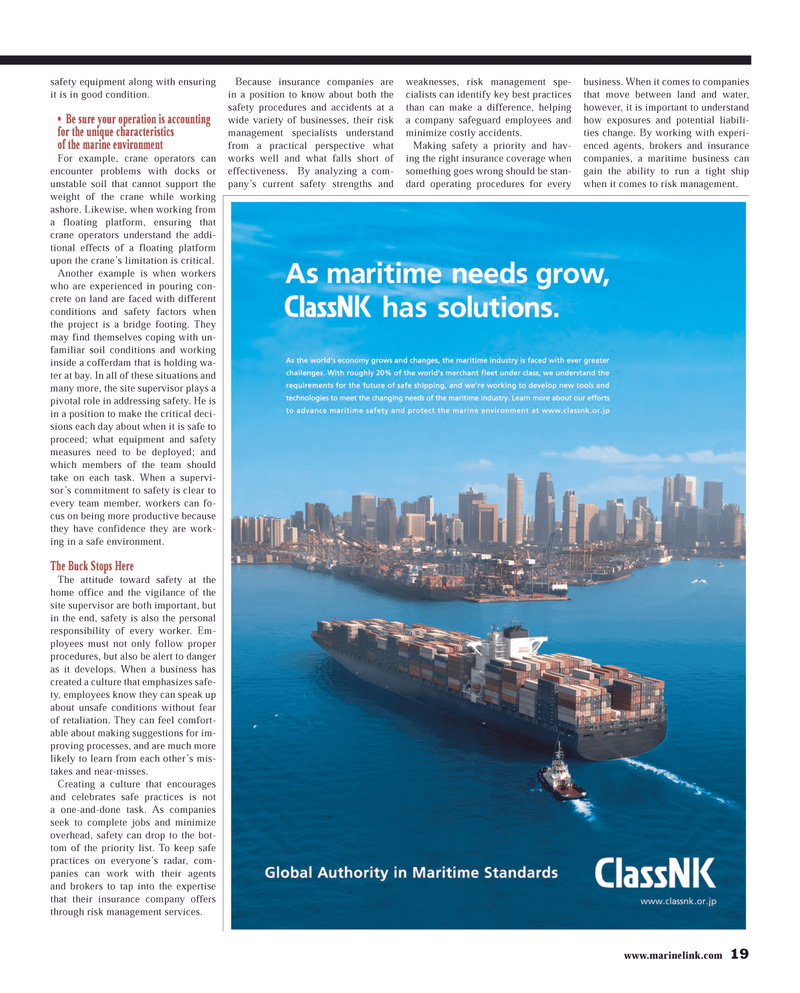
Page 19: of Maritime Reporter Magazine (March 2013)
U.S. Coast Guard Annual
Read this page in Pdf, Flash or Html5 edition of March 2013 Maritime Reporter Magazine
www.marinelink.com 19safety equipment along with ensuring it is in good condition.? Be sure your operation is accounting for the unique characteristics of the marine environment For example, crane operators can encounter problems with docks or unstable soil that cannot support the weight of the crane while working ashore. Likewise, when working from a floating platform, ensuring that crane operators understand the addi-tional effects of a floating platform upon the crane?s limitation is critical. Another example is when workers who are experienced in pouring con-crete on land are faced with different conditions and safety factors when the project is a bridge footing. They may find themselves coping with un-familiar soil conditions and working inside a cofferdam that is holding wa- ter at bay. In all of these situations and many more, the site supervisor plays a pivotal role in addressing safety. He is in a position to make the critical deci-sions each day about when it is safe to proceed; what equipment and safety measures need to be deployed; and which members of the team should take on each task. When a supervi- sor?s commitment to safety is clear to every team member, workers can fo- cus on being more productive because they have confidence they are work-ing in a safe environment. The Buck Stops Here The attitude toward safety at the home office and the vigilance of the site supervisor are both important, but in the end, safety is also the personal responsibility of every worker. Em- ployees must not only follow proper procedures, but also be alert to danger as it develops. When a business has created a culture that emphasizes safe-ty, employees know they can speak up about unsafe conditions without fear of retaliation. They can feel comfort- able about making suggestions for im-proving processes, and are much more likely to learn from each other?s mis- takes and near-misses. Creating a culture that encourages and celebrates safe practices is not a one-and-done task. As companies seek to complete jobs and minimize overhead, safety can drop to the bot-tom of the priority list. To keep safe practices on everyone?s radar, com- panies can work with their agents and brokers to tap into the expertise that their insurance company offers through risk management services.Because insurance companies are in a position to know about both the safety procedures and accidents at a wide variety of businesses, their risk management specialists understand from a practical perspective what works well and what falls short of effectiveness. By analyzing a com- pany?s current safety strengths and weaknesses, risk management spe-cialists can identify key best practices than can make a difference, helping a company safeguard employees and minimize costly accidents.Making safety a priority and hav-ing the right insurance coverage when something goes wrong should be stan-dard operating procedures for every business. When it comes to companies that move between land and water, however, it is important to understand how exposures and potential liabili-ties change. By working with experi-enced agents, brokers and insurance companies, a maritime business can gain the ability to run a tight ship when it comes to risk management. MR #3 (18-25).indd 19MR #3 (18-25).indd 192/26/2013 3:50:54 PM2/26/2013 3:50:54 PM

 18
18

 20
20
